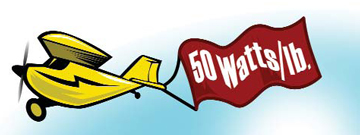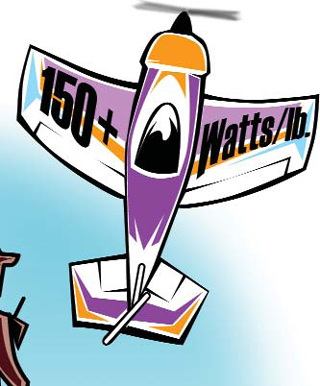Why does it have to be this complicated? If I had a dollar for every time Ive heard that question asked by fliers who are trying to match electric power systems with airframes, Id be a rich man. In the glow and gas world, the process is pretty simple: just pick an engine at or around the top end of the recommended range and one of the few props listed on its data sheet, and youre good to go. Electrics, on the other hand, can be confusing and frustrating because of the absence of a standard way of designating motors, confusing terminology and a general lack of familiarity. Terms and abbreviations such as Kv, rpm, volts, amps and cell count make the process seem insurmountable. This month, I demystify things a little by simplifying the decision down to one wordwatts.
So, what is a watt? Its a unit of work. It is the measure we use to define the amount of work our electric power systems are capable of doing. Think of watts as the amount of power well use to turn the models propeller. Each and every motor has a maximum wattage that its capable of delivering at a sustained rate without either overheating or failing mechanically. Most manufacturers give us this data for their motors, and we can use it to determine a motors suitability for a particular airplane. Although Ill talk about this further in another installment of “Primary Training, watts are by definition the product of amps and volts:
Volts x amps = watts

This is the only equation I think is absolutely necessary to understand in electric flight, and thats good because the fewer the equations the better. If you increase either the voltage (think extra cells) or the amperage (think of this as the load on the motora larger prop, for instance) the total wattage will increase. Conversely, if you decrease either the voltage or the amperage, the wattage will decrease.
WATT DECISIONS & POWER LOADING
So, watts = power. That begs the question: how much power do you need? My Slow Stick requires dramatically less power to be fun than a 3D airplane of a very similar size. Likewise, a racing model will demand far more power than a sport airplane of a similar size. Flying performance clearly has a part in the motor/airframe decision process. What about larger and smaller models? The defining feature of each type is its weight, so Ill use that as well as your intended flying style to determine the appropriate power for a models weight, or its “power loading. With electric models, we use watts per pound (W/lb.) as the preferred unit of measure. Check this chart for approximate power loadings for differing flying styles:
 RECOMMENDED POWER LOADINGS
RECOMMENDED POWER LOADINGS
50 W/lb. ……….Trainers and slow flyers
75-100 W/lb….Basic aero/sport flying
125 W/lb. ……..Precision aerobatics
150+ W/lb. ……Extreme 3D performance
Although these numbers are not absolutes, they certainly give us a starting point, and most models will fit this chart quite nicely. Applying this to a 5-pound 3D airplane, youd need at least 750 watts for minimum 3D performance (5 lb. x 150 watts/lb.). On a smaller scale, a 10-ounce sport model needs roughly 62 watts of power (0.625 lb. x 100 watts/lb.)
EFFICIENCY
Any discussion about watts and watts/pound isnt complete without touching on motor efficiency. No electric motors are 100 percent efficient. Even the most efficient motors waste around 10 percent of the energy drawn from the battery, while many lowerquality brushless motors have efficiency losses as high as 30 or even 40 percent. Most motors fall in the 10- to 20-percent-loss range. This efficiency loss is generally seen as motor heat, and it decreases the amount of power available to turn the propeller.
When we measure power with a wattmeter, we are measuring the power output of the battery to the motor – not the final output from the motor itself. The numbers seen on the wattmeter do not take into account the efficiency of the motor itself or the losses they create. With that in mind, the “Recommended power loadings chart takes into account average losses in efficiency, so you do not need to adjust the numbers for the motors lower actual output wattage.
Generally speaking, inrunner motors run more efficiently than outrunners, but operationally, for average modelers, the difference between the two is minimal and goes unnoticed. As you get more experienced and begin to demand the best possible performance, motor efficiency takes on a dramatically more important role, but for 99 percent of us, it just isnt all that critical.
 CONCLUSION
CONCLUSION
As you can see, determining the correct power loading is the first step in matching an electric power system to your airplane. First, establish the performance you want by comparing the chart with your intended flying style. Next, multiply that W/lb. figure by the models intended flying weight to find the minimum number of watts required. It may take some tinkering on your part to find the perfect setup, but using the power-loading chart as your primary tool will at least get you into the ballpark. Keep in mind that these numbers are the minimum required for each flying style, so it may be prudent to exceed them slightly to ensure adequate performance.
On the other hand, adding unnecessary weight can dramatically alter the flying characteristics of a model by increasing its wing loading. Whats wing loading? Good question, but it will have to wait until next month. Finding the right balance between weight and power is the goal.
Good luck with your decisions, and remember that learning makes RC fun, and fun is what this hobby is all about.
 Fly RC Magazine WE LIVE RC
Fly RC Magazine WE LIVE RC
